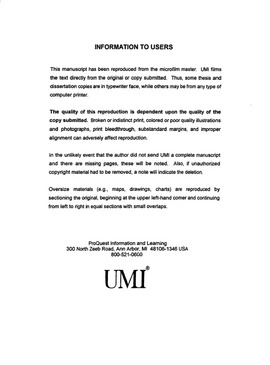| dc.contributor.advisor | Maiden, Jeffrey, | en_US |
| dc.contributor.author | Hernandez, Norbert Gilbert. | en_US |
| dc.date.accessioned | 2013-08-16T12:18:56Z | |
| dc.date.available | 2013-08-16T12:18:56Z | |
| dc.date.issued | 2003 | en_US |
| dc.identifier.uri | https://hdl.handle.net/11244/584 | |
| dc.description.abstract | To investigate the research questions for the study, both analysis of existing district data and a quantitative method to isolate educator concerns, the Stages of Concern Questionnaire (SoCQ), were used. This study looked into a constant dilemma faced by American educators: the implementation of an innovation without an adequate vision or attention to such a vision after implementation in order to address all aspects of the implementation process. Specifically, district overall budgets, professional development budgets, technology plans, and technology professional development strategies were isolated for FYs 199-2001 to examine technology inclusion. Educator concerns were isolated about the implementation of computer technology as well to determine not only immediate educator concerns, but to also address professional development strategies for educators in the district as a result of those concerns. The study was structured in this manner in an attempt to faithfully address the fidelity of implementation issue researchers found important for the introduction of an innovation in education. | en_US |
| dc.description.abstract | The implementation of computer technology in America's schools has been expensive. Billions of dollars from federal and state governments, businesses, and private sources have enabled school districts across the nation to implement the hardware and software to connect to the Internet and provide access to technology in classrooms. The implementation process, however, is just the first step in computer technology inclusion. Just as important is how the technology is being used after implementation. The focus in the literature has begun to shift from the importance of technology implementation to the importance of technology use after implementation. The literature contended that such a shift must include technology professional development for educators involved. This study examined technology inclusion in a southwest Oklahoma school district by examining educator concerns about technology inclusion and technology professional development strategies for educators after the implementation process. | en_US |
| dc.description.abstract | The study's findings indicated that technology implementation and the effective use of technology after implementation hinged on technology professional development for educators. Funding for technology preparation for educators was severely limited after implementation, and although the district had provided a vision for technology inclusion, both the funding and the strategies weren't able to address district expectations for technology inclusion after implementation. Without organizational direction and support both in funding and long-range educator technology professional development, the expectation for the inclusion of technology to enhance student learning cannot be met. Concerns reflected through the SoCQ indicated that district educators were primarily still concerned with how to use the implemented technology and how it would affect them. | en_US |
| dc.format.extent | xii, 192 leaves ; | en_US |
| dc.subject | Education, Technology of. | en_US |
| dc.subject | Education Data processing Case studies. | en_US |
| dc.subject | Education Data processing Oklahoma. | en_US |
| dc.subject | Education, Teacher Training. | en_US |
| dc.title | Educator concerns about computer technology implementation in a southwestern Oklahoma school district. | en_US |
| dc.type | Thesis | en_US |
| dc.thesis.degree | Ph.D. | en_US |
| dc.thesis.degreeDiscipline | Department of Educational Leadership and Policy Studies | en_US |
| dc.note | Source: Dissertation Abstracts International, Volume: 64-03, Section: A, page: 0868. | en_US |
| dc.note | Major Professor: Jeffrey Maiden. | en_US |
| ou.identifier | (UMI)AAI3082941 | en_US |
| ou.group | Jeannine Rainbolt College of Education::Department of Educational Leadership and Policy Studies | |
